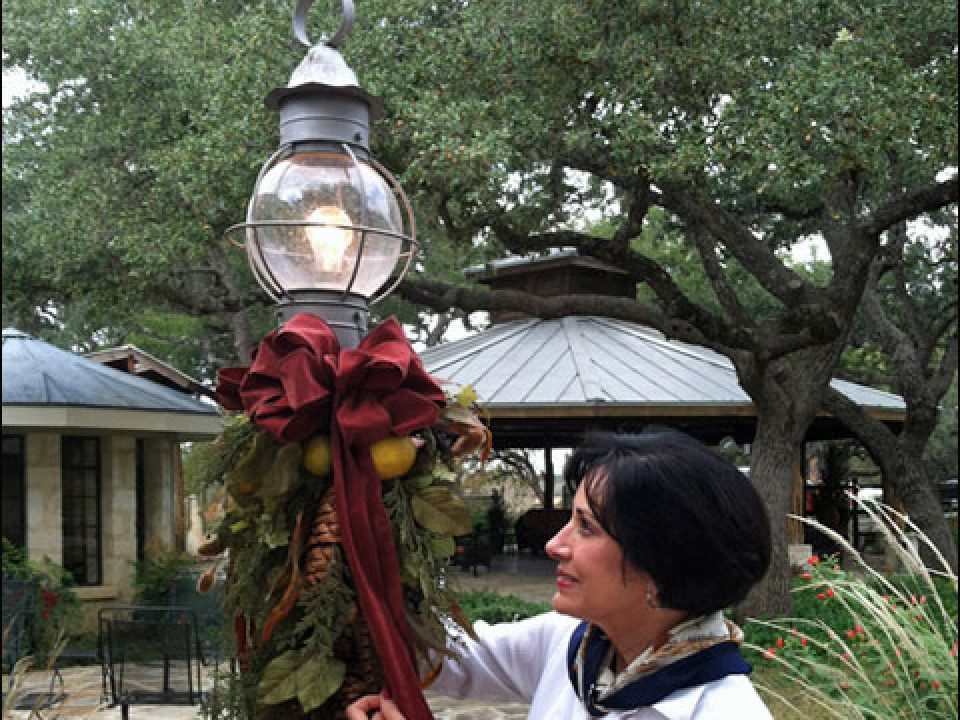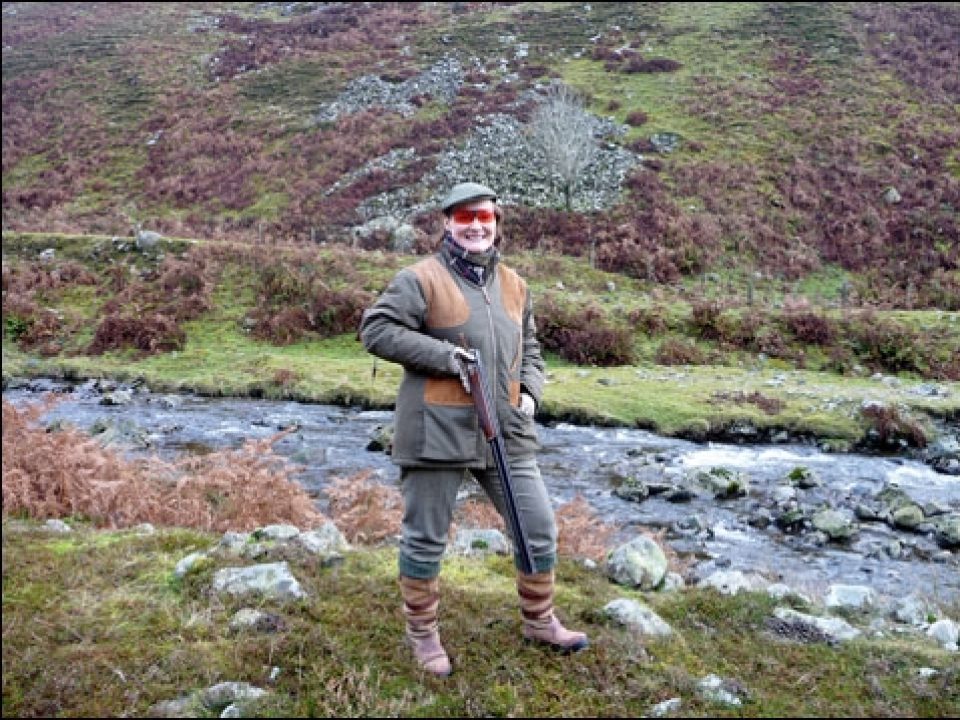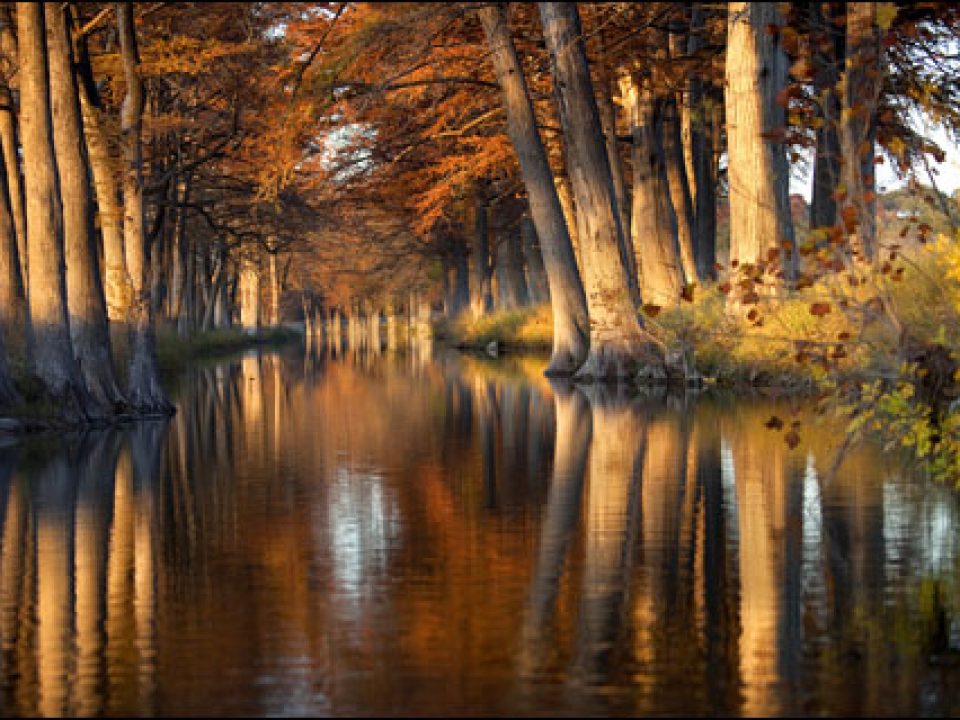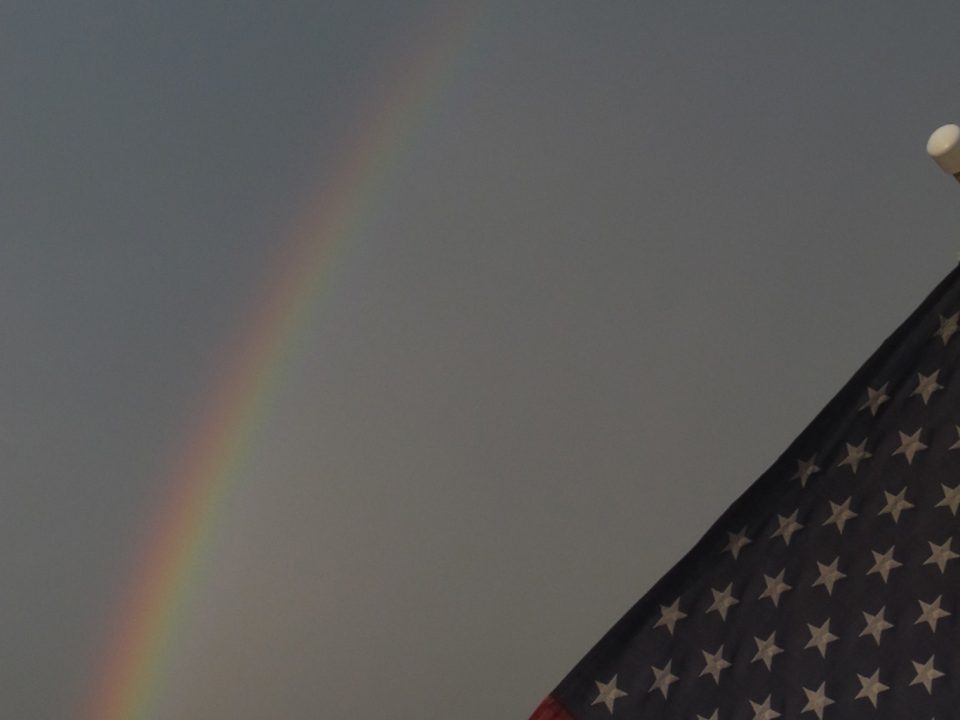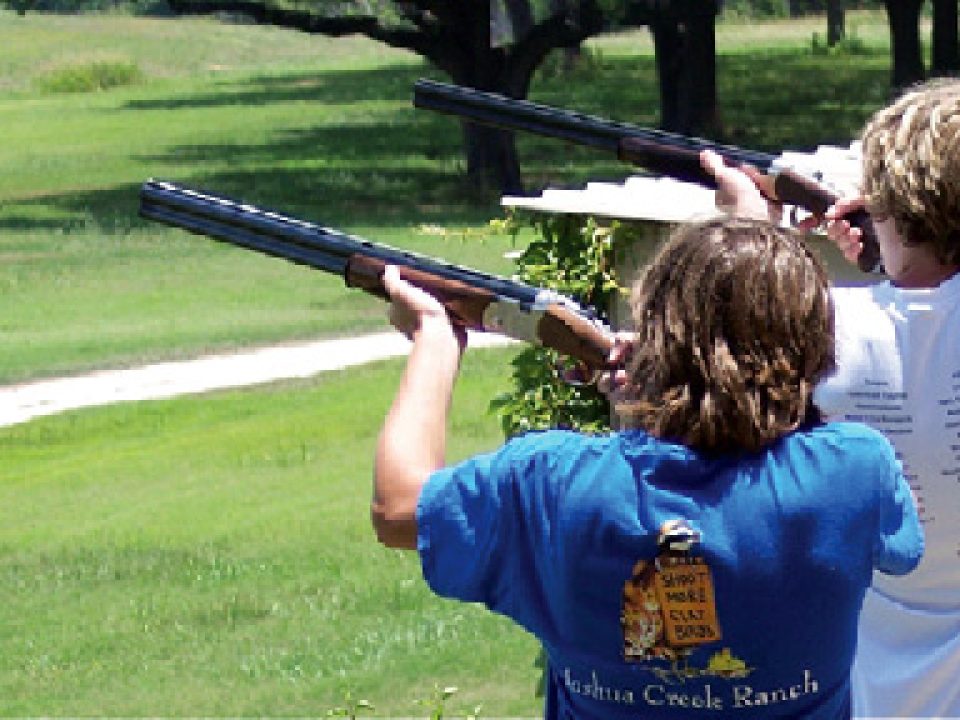I’m glad when Thanksgiving comes early in the month of November as it did this year, because it’s always the week after Thanksgiving that I put up our Christmas decorations. It seems disrespectful to the Thanksgiving tradition to adorn the house with Christmas decorations prior to the celebration of Thanksgiving. But I love elaborate Christmas decorations; it’s a trait I inherited from my mother and grandmother. And because of all the work involved in putting up all those decorations, I like to have them up early and keep them up for a long time….like a couple of months. Plus I like to add a few new ones each year. But most of all, I like putting all of the beautiful decorations we’ve collected over the years in different places around the house than they were last year. It makes them seem new all over again….this shotgun-toting Santa here, that toy-laden sleigh there, this new ribbon on that favorite old wreath, and best of all, adorning our Christmas tree with the ornaments that we’ve collected from our travels all over the world for 30 years. Just decorating the tree is a trip down memory lane that takes us back to Africa, Argentina, Scotland, Hungary, Austria, England, Canada, Alaska and on and on.
Shotgun Lives
The Spirituality of Sporting Clays
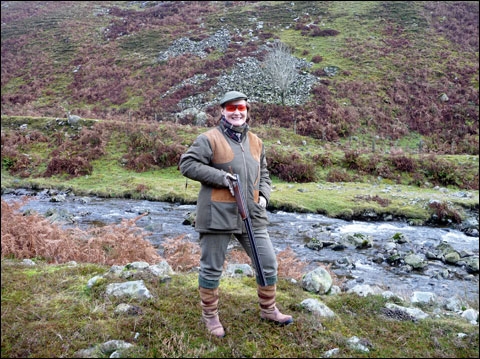
Summer had arrived with a vengeance here in the northeast with soaring temperatures and very little rain. Even so, as James Taylor croons in one of my still-favorite songs, “It’s my favorite time of the year.” It’s that time of year when we can sit back and kick back and yes, focus on our spiritual life.
Optimism and Opportunity
In “Shotgun Wife” a month ago (October, 2012), I revealed my political preferences by encouraging Americans to get behind the 2012 election of conservatives at every level of government. That was a risky move for me since I really dislike confrontations and knew I was potentially inviting that very response. But I had to take the chance and brace myself for the possible backlash because this election is all about rescuing the future of our great nation from its march toward socialism and financial collapse.
Duck hunting and the perils of getting your hopes up
When it comes to duck hunting, I’m the functional equivalent of a 7-year-old. This is my seventh season of hunting, and every time I go out, regardless any indications that would temper the optimism of a wiser hunter, each hunt always holds the promise of Christmas. There’s always an excellent chance that the ducks will swarm around the blind like mosquitoes, my shooting will be immaculate, and the day will be one I remember forever.
The American Dream – Keep It Alive
When we first opened Joshua Creek Ranch for hunting and sporting clays, I was very cautious about the terms used to describe our business, using words like “game preserve” and “harvesting game” to soften the impact on anyone who might be offended by wingshooting or deer hunting. When asked what kind of work I did, I preferred to lead with the fact that at JCR we shoot clay targets rather than jumping right in with the truth that the primary targets around here are birds and deer. The last thing I wanted was to be confronted by anti-gun or anti-hunting activists. Even when I was confronted, I’d listen politely, reply with something like “to each his own,” and escape the scene as quickly as I could. I always avoided situations that might erupt in confrontation if I started delivering volumes of facts and figures about the valuable effects of hunters on wildlife populations and their habitat, or about the positive impact on crime rates when citizens own guns. I was too kind, not wanting to offend anyone; after all, they had a right to their own opinion. I was one of many naïve people who thought that the freedoms we enjoy in America weren’t endangered and couldn’t possibly be lost, at least not in my lifetime.
The wrath of the duck gods, or how to avoid wrecking a hunt
Duck season approacheth in my neck of the woods, and that means it’s time to remember the three immutable rules of the duck gods:
1. Don’t be a snob. I think my friend and hunting guide Jason Adversalo expressed this principle the most clearly: “Someone’s got to kill a spoonie. Until someone kills a spoonie, we’re not going to have a good hunt.”
Prognostications of a Dedicated Slayer of Tasty Little Doves
Last weekend found me at my high school reunion in Visalia, California, seated amongst a bunch of my Class of ’83 brethren who were generally quite happy to find that I’d joined the ranks of gun-totin’, wildlife-killin’ mamas. I was not a fan of guns back in the day, and my family preferred slaughtering animals we’d raised ourselves.
We were lamenting the fact that our reunion hadn’t been one week later, when I could have enjoyed a dove hunt or two while I was there. I’ve never gone dove hunting there, deep in the middle of the San Joaquin Valley, but I vividly remember quiet country mornings punctuated by the gentle call of the mourning dove. I used to call back at them with my Tonette, a little red plastic flute that’s like a recorder, only much easier to play. As an adult who hunts now, that memory translates into, “Mmmmmmm, bet there’s some good huntin’ there…”
“You should come back down!” my friend John said.
“I wish. I have so much work to do,” I said. I already knew this reunion would set me back so enough that I’d be hyperventilating within days. (I was right, but who cares – it was fun.)
“I know this great spot…” he said.
“Oh yeah?” I’ve never been one to fight Temptation very hard. I kinda dig Temptation.
“Yeah, two years ago I got my limit of 10 with 12 shots.”
I should mention that John is a competition shooter.
“And how’d that spot do last year?”
He shook his head. As I expected.
Two years ago we had an epic dove season in California. Can’t say I ever got a limit in 12 shots, but I got quite a few limits, and there were several days where we literally couldn’t reload fast enough for the next birds coming through. It was exciting and delicious. We ate so much dove that year. And we ate ‘em a dozen different ways, all awesome.
And then there was last year. Holy crap, it took me six hunts to get a single limit, and my shooting wasn’t the problem. The doves, which had been around all summer in substantial numbers, were just gone.
Compounding the shortage of doves was the weird weather. The rain had kept coming hard that spring, even into early summer, and the harvest of most seed crops – including the delicious and holy dove attractant safflower – had been delayed. The previous year, the safflower field I’d hunted had been plowed, providing attractive open territory for the nervous little birds. This time around, though, it had been cut, but not plowed, making those fields a scarier place for the doves.
The hunting was so bad that I resorted to something really goofy: If I spotted a few doves flitting into the middle of that big old field, I would get up and walk very quietly through the 6-inch-high safflower stalks to where I thought they’d be. I could often get within 20 yards, at which point their heads would pop up and they’d get that “Oh shit!” look on their faces, and they’d flush.
Most of the time I shot well enough to drop at least one, and somehow I managed to find all that I dropped, despite how well they blended in with the soil, and the fact that I wouldn’t regain sight of them until they were right in front of me. Pretty sure I got about half of my birds that way last year.
So now, people like John and me are asking ourselves: What’s it gonna be this year?
And I have a prediction: The doves are going to be really dumb.
I know that sounds insensitive, and shame on me, because I actually do have a tremendous amount of respect for wild animals, and like most of them better than I like most people. However, there is a basis for my statement.
For the past three summers, I have trapped and banded mourning doves in my front yard in cooperation with (and under the license of) the California Department of Fish and Game and the U.S. Geological Service. For the past three summers I have seen distinctly different behaviors.
My first summer, the banding was epic. I trapped one bird three times (obviously he was very traumatized by the experience), and one day I trapped three birds 15 minutes apart – they just couldn’t wait until I left the front yard so they could come down off the roof and dive into that trap. That year, the dove season was epic.
Last summer, the banding wasn’t as good, though get this: I trapped the bird that I’d trapped three times the summer before, and three days after I trapped him, he was trapped by another bander 500 miles away in Palm Springs. That’s how doves roll.
But I digress. During the last week of banding season (which ends 10 days before dove hunting season starts) my trapping was really anemic. It seemed like the doves had all just left. And lo and behold, we had a crappy season.
This summer was again very different. The first thing I noticed was that the doves would be here in droves one day, then utterly absent for a week.
And while I didn’t re-trap any birds this year, I generally found the doves in my neighborhood to be entirely too trusting. I would pass within five feet of them on morning runs and they wouldn’t flush. And in my own front yard, I could pull into the driveway, unload groceries and walk into my house and the doves wouldn’t move.
That’s dumb. Seriously, I can’t believe they weren’t all eaten by the neighborhood cats.
So what does this mean for this dove season?
I have no clue. But I’ll start finding out today.
Holly A. Heyser is a hunter, forager, writer, photographer and college journalism lecturer who lives in Sacramento, California. You can see more of her work at hollyheyser.com.
Prescription for Summer Fun ‘til Dove Season Comes Around
What a wonderful summer it has been at the Ranch, the first half with mild temps and frequent rains, and the last half, a real sizzler…..hot and dry. But throughout it all, sporting clays enthusiasts have spent a lot of time and ammo having a heck of a lot of fun here, especially the last half of August when shooters were practicing for the Dove Season opening September 1st.
The Law of Natural Consequences
Living on the ranch where I work affords me the good fortune of an incredibly short and beautiful commute from my home to my office. The only things I miss from my former 30- minute morning and evening commutes are the news and talk radio. In my brief five-minute morning drive not long ago, I turned on the radio to hear Glenn Beck talking about a camp where kids are out seeing nature in action. He talked about how nature teaches patterns in life for everything, even families. One thing he said that really got my attention were these words: “plug in means tune out.” Glenn was referring to the modern trend of youngsters being entertained by electronic devices rather than engaged in outdoor activities.
We see evidence of this when 100+ youth ages 8-15 attend the Youth Outdoor Adventure Program (YOAP) over the summer months at Joshua Creek Ranch. The first-timers do suffer withdrawal when they realize they’re allowed no television, internet, cell phones, electronic games, etc. Their 10 days at YOAP are all about the outdoor sporting life. You could call it iOutdoors. But there’s no iPhone app for it. The application is 100-percent, real natural outdoor settings with their hands on real shotguns, rifles, bows, arrows, fishing rods, kayaks and oars. Yes, the application requires nimble fingers and quick reflexes, but not for pushing buttons.
Anyway, I agree with Glenn Beck about nature being a great teacher. You can’t be out in it without noticing the wondrous intricacies of how miraculously it works. I’ll share some examples that we loved seeing these kids observe:
One of the favorite recreational areas at the ranch is spring-fed Joshua Creek. The kids love swimming and fishing there, but last summer the drought was so severe that we had no flowing water in the creek. This year when kids returned they were awed to see the effect of rain on the creek. And when we had a night of thunderstorms while those kids were at the ranch, they were filled with anticipation about the impact the rain would have on the water flowing in the creek. The next day they were happy to see the significant rise in the water level, but not so pleased to see the temporary muddy condition created by the runoff that were both a consequence of bountiful rainfall.
At the beginning of each and every session of the youth program, we have a traditional initial activity. Counselors vie for the opportunity to paint a face on a sacrificial watermelon. The kids are gathered round while the caricaturized melon is set on a rock wall about 20 yards away. With all eyes fixed on the happy green face, a counselor mounts a shotgun, takes aim and shoots the unsuspecting melon-head. The explosion of red mush splatters in every direction. The effect astounds the kids and the lesson is taught. They’re about to engage in 10 days of a fun sport that can have deadly consequences if not conducted in a safe manner.
 A couple of boys at the Joshua Creek Youth Outdoor Adventure Program learn shotgunning.
A couple of boys at the Joshua Creek Youth Outdoor Adventure Program learn shotgunning.We watched another of the laws of natural consequences unfold during one of the youth program sessions. Every year a pair of barn swallows return to our office porch and attaches their nest to one of the ceiling joists near our front door. For some reason, these adorable little birds just love to nest right over doorways where, of course, they leave an incredible mess. But they are so much fun to watch that the mess is tolerable for their short migratory duration. Last year, this pair had four hatches out of their summer nest under the porch. But this summer, the second hatch ended badly. It happened during one of the youth sessions that it was time for the fledglings to learn to fly and leave the nest. The parent birds circled the nest incessantly to demonstrate how to fly, sometimes stopping to perch on the edge to deliver a chirp of encouragement. One by one the little birds stepped onto the edge and took their first brave leap into winged flight. But among them was one fledgling that would not get off the edge. The parents kept circling and swooping. They even lit on the ground below the nest as if to demonstrate that it would be safe to land there if his first attempt to fly was not successful. But he never would take the leap. After a long while, the parent birds gave up, departed, and did not return. The baby bird just continued to sit on the edge of the nest. Then later when we looked, he had gotten back into the nest. The parents never returned, the baby bird never got back on the edge and so he never took the leap to fly. He died in the nest. We talked about how these parents had done everything they could for their fledgling. They’d fed him and made him strong enough to fly, they’d demonstrated flight, they’d continuously encouraged him, they’d even shown him that he could safely land just below the nest if necessary. But they couldn’t make him take the leap, so they finally gave up and so did he. It was a tough life lesson to watch, but an incredibly valuable example of the law of natural consequences.
To intersperse the action of shooting, archery, and river sports with the intrigue of little things like catching just the right bug that will lure the big fish of the day is to take those steps that ultimately create a life-long bond with that great teacher, nature. Interestingly, when the 10-day sessions of the Youth Program end, there’s no mad dash for iPhones when the kids get picked up. In fact, there are generally clamorous petitions for staying longer or coming again next year. Nature and real outdoor experiences have an appeal that often outshines those fascinating electronic devices
Rabbit hunting ain’t easy. Right?
Upland vest on, fistful of shells in pocket, shotgun in hand, good. Now close the car door quietly and walk over the levee in the burgeoning pre-dawn light.
I was a little more nervous than usual on this rabbit hunt in July because I was not alone – a woman from Berkeley was filming my hunt for possible inclusion in a documentary.
Shotgun Life Newsletters
Join an elite group of readers who receive their FREE e-letter every week from Shotgun Life. These readers gain a competitive advantage from the valuable advice delivered directly to their inbox. You'll discover ways to improve your shooting, learn about the best new products and how to easily maintain your shotgun so it's always reliable. If you strive to be a better shooter, then our FREE e-letters are for you.
About Shotgun Life
Shotgun Life is the first online magazine devoted to the great people who participate in the shotgun sports.
Our goal is to provide you with the best coverage in wing and clays shooting. That includes places to shoot, ways to improve your shooting and the latest new products. Everything you need to know about the shotgun sports is a mouse-click away.
Contact
Irwin Greenstein
Publisher
Shotgun Life
PO Box 6423
Thomasville, GA 31758
Phone: 229-236-1632

